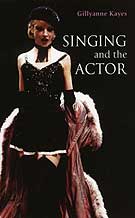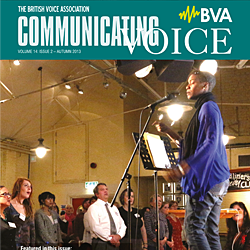About the Association
Archived book reviews
 Singing and the Actor (2nd edition)
Singing and the Actor (2nd edition)
Gillyanne Kayes
A & C Black, 2004. ISBN 0-7136-6823
Review by: David Carey (April 2006)
The second edition of Gillyanne Kayes' Singing and the Actor retains the original's commitment to providing an informed and practical training programme for the contemporary singing actor, and also preserves its essential structure, but in many other ways improves on the first edition. The text has been given a thorough revision to allow for new insights and further information, clearer presentation and a fresh tone.
In particular, Kayes has addressed the needs of readers who have different learning styles by including a range of 'strategies for processing information and developing muscle memory', and there is also a more detailed consideration of important aspects such as registers and gear changes, and of working with different voice qualities.
For BVA members who have yet to read this manual by one of our leading vocal trainers, it consists of three main sections: How the Voice Works, Training Your Voice, and Working the Text. How the Voice Works provides the reader with a clear and practical understanding of the functional anatomy of the voice, how it works (obviously!) and, perhaps more importantly, how and why it may not work. Individual chapters introduce the reader to the vocal mechanism, in particular the larynx, and to key concepts such as constriction/ deconstriction, effort monitoring, laryngeal postures, and breath support. The reader is asked to engage actively with the material by means of valuable practical exercises that serve to develop awareness and control, and by song assignments that provide the necessary application and development of concepts and skill.
The second section, Training Your Voice, focuses on the real substance of a singer's training - range, resonance, gear changes, vowel placement, and dynamic control. Further key concepts are introduced and applied incrementally through exercises and assignments: sirening and mirening (sirening while mouthing words simultaneously), opening and closing the nasal port, anchoring for vocal support, thick/thin folds, twang, and medialisation of vowels. While much of this work may now be familiar, particularly for singers and teachers with a background in Estill Voice Craft, Kayes not only presents it in a clear and accessible form but has also integrated it into a pedagogical process which has clear application to the singing actor.
Section Three: Working the Text takes the reader through the process of preparing a song for performance. Kayes demonstrates how to apply all the tools and concepts previously explored to the reader's own choice of song; she addresses issues of singing the text, such as maintaining vowel integrity, bringing clarity to consonants, and communicating the text with meaning; she also considers advanced work on creating voice qualities such as falsetto, cry and belt and their use in song interpretation before concluding with a worked through example of applying a useful 5 point process to the song Anyone Can Whistle.
This is a highly useful text, not only for singing actors and their teachers, but also for all voice professionals interested in the specific development of the voice as an expressive instrument. The only criticism I have is that, while there is a number of very useful phonetic charts at several points in the text, these are insufficiently referenced or explained. In all other respects, this is a very well presented and illustrated practical handbook, which constantly engages the reader as a partner in his/her own learning process.
A new CD Audio Guide to accompany the book containing examples in both the male and female voice of all the voice qualities described in the book is in the final stages of production and will be available through Vocal Process.
More archived content online
Disclaimer
Neither the British Voice Association nor the Editor can be held responsible for errors or any consequences arising from the use of information contained in its newsletters (or extracts from its newsletters published online); the views and opinions expressed do not necessarily reflect those of the British Voice Association (BVA) or the Editor, neither does the publication of advertisements constitute any endorsement by the BVA or Editor of any products or services featured.

 Join us Now!
Join us Now! our newsletter
our newsletter free voice care leaflets & information – download here
free voice care leaflets & information – download here Help our work by donating while you shop
Help our work by donating while you shop